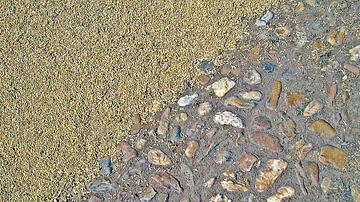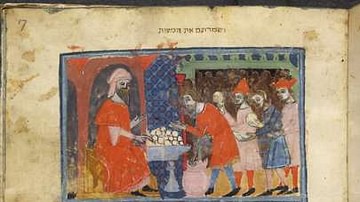The threshing floors of the Bible were outdoor stone floors, usually circular in fashion, used by farmers to process the grain of their crops. For the larger community, like watermills of the recent past, they could be gathering places bustling with commercial and communal activity.
Threshing floors served several purposes:
- As agricultural processing facilities and places of commercial activity.
- As places that have symbolic meaning.
- As neutral places of gathering.
- As places of political treaty.
- As places of mourning.
- As places of sacrifice.
- As building sites.
As Processing Facilities
While threshing floors in ancient Israel had significant social and symbolic value, their function as agricultural facilities to process grain was primary. Something we all depend on for sustenance, the harvesting of grain is a process of gathering and separation. For example, with corn, after the stalks are gathered, the cobs are separated from the stalk, then their outer leafy husks are detached. For animal feed, the cobs can be consumed whole. For human consumption, the kernels on the cob, with their soft hulls left intact, are removed. The kernels are consumed or dried and ground into flour. With wheat or barley, the outer harder hulls of the seed are broken or 'threshed' from the seed.
In ancient times threshing was performed by hand on the threshing floor with wheels, sledges, or hinged wooden rods called flails. This flailing or threshing process was aided by the wind blowing the lighter broken hulls or chaff away from the grain after being released into the air from a fork, shovel, or shallow basket. Called winnowing, this left the heavier delectable seed on the threshing floor to be gathered. In the book of Ruth, we get a good idea about harvesting in Biblical times. Boaz, a community leader and 'man of standing,' owned land on which he grew barley and wheat. With an overseer in charge of men and women, his laborers gleaned and gathered stalks from the fields that were bound in manageable bundles called sheaves to be taken to the threshing floor. After the threshing and winnowing process, while waiting for his harvest to be transported from the threshing floor for storage, to protect it from theft he (likely with others) slept near the pile of grain as it lay overnight on the threshing floor. The bounty of his crop is indicated when Ruth, who Boaz would later marry, went to Boaz that night; she found him on the threshing floor "at the far end of the grain pile." (3:7)
Location & Structure
One of the things that made threshing floors unique was the specific meteorological and geographical conditions required for their location. The winnowing process's great advantage often determined the threshing floor's location. Hosea 13:3 vividly describes how chaff was separated from the grain by the wind: "Like chaff swirling from a threshing floor." or when Isaiah references the winnowing of chaff as "the wind will pick them up, and a gale will blow them away." (Isaiah 41:16) Thus, a place with strong, steady winds with access to district farmers, and a plot of ground flat enough to accommodate the threshing floor structure, was preferred and often determined a threshing floor's location. Jamie Waters points out, "as their flat floors are often situated in areas with wind accessibility . . . hilltops were traditional locations." (9, 11) The Biblical text also indicates the preference for elevated locations when King Jehoshaphat of Judah and Ahab, king of Israel, met at the threshing floor of the city of Samaria, located near the entrance gate. This city, named after its original owner, Shemer, was built on a hill. The idiom in the book of Isaiah, "driven before the wind like chaff on the hills," likewise confirms the winnowing process of locations on higher ground. (17:13) Additionally, as the temple in Jerusalem was built over a threshing floor, Victor Hurowitz observes, “This site was chosen because it was outside the city and was elevated. In ancient Israel threshing floors were located at places where the wind would blow freely to facilitate winnowing.” (10:2)
The threshing and winnowing process also determined the threshing floor's structure. To facilitate the gathering and threshing of the grain, especially with sledges pulled by animals going in a circle, most threshing floors were round, with curbs added to the perimeter of the threshing floor structure. So the cereal could be sufficiently threshed from its hulls, a hard surface area was required, usually of closely spaced stones, hewn rock; even plaster was used. As Waters shows,
Excavations in Samaria have uncovered several agricultural installations, including multiple threshing floors, wine presses, and olive presses dating roughly from the Hellenistic period to the Roman period. These threshing floors were typically level areas cut into rock, some with stone fences around them, and almost always on the outskirts of a settlement. (9)
Additionally, in Israel, 6 km northeast of Caesarea, a residence dated between the first century BCE to the first century CE was excavated by Y. Hirschfeld and R. Birger-Calderon. They discovered a courtyard with a wine press, olive press, and a threshing floor. The rock-hewn semi-circular threshing floor area measured 7.6 meters (25 feet) by 1.8 (6 feet) meters. The size and shape of this threshing floor led the excavators to conclude the grain was threshed with flails. In Cyprus, the ethnoarchaeological study by John Whitaker reveals threshing floors were sometimes plastered. While in northern Greece, to utilize scarce arable soil, Georgia Tsartsidou discovered threshing floors were dismantled every year after harvest to cultivate the same plots of ground before the following year's threshing when new floors would be installed.
Commercial Activity
That their use was essential, and their locations required specific conditions meant threshing floor areas were unique and valuable to their owners. That meant the proprietor would benefit economically with a charge-of-use, of a likely percentage take of the harvest. Threshing floors could have single ownership or be owned by a village, city, or perhaps even the king. Interestingly, the threshing floor at Samaria was prominently located at the city's gate. Controlling the flow of people, city gates were often places of social, political, and business exchange. Moreover, since the newly built Samaria and its threshing floor were contiguous suggests Samaria’s threshing floor may have played a role in the city’s choice for a building site. Either way, it is hard to imagine king Ahab would not have taken proprietorship of such an essential structure near the gates of the capital city his father Omri built. In other instances, threshing floors were owned by ordinary individuals. While it is generally believed the 'threshing floor of Atad' was named for its location as “a place of thorns," and was owned by the village that grew up around it, the 'threshing floor of Nakon' was more likely named after a person. (Ellicott, 674-75) But the 'threshing floor of Araunah' certainly was owned and named after Araunah, a Jebusite from Jerusalem. Araunah’s threshing floor was purchased from Araunah by king David for fifty shekels of silver.
Regarding business activity, since their locations were unique and harvest time was limited, threshing floors were likely crowded with area farmers at the height of harvest season. Additionally, interestingly enough, the Bible mentions the presence of prostitutes at threshing floors. Speaking about their unfaithfulness to their god, Hosea reproaches the Israelites saying, "you love the wages of a prostitute at every threshing floor." (Hosea 9:1) Beyond the sentence as an idiom; that wages, prostitution, and threshing floors are associated suggests a basis in real life activity. If that is so, as prostitution historically links itself to commercial activity, for them to have plied their trade at threshing floors, suggests an ample degree of business activity, especially at the height of harvest season.
Symbolism
As phrases from threshing floor processes, like 'separating the chaff from the wheat' or 'bringing in the sheaves' - a refrain of an old gospel song - have been used allegorically, in ancient Israel threshing floors themselves held a surprisingly significant cultural and symbolic place for the communities they served. As idioms within the Bible: synonymous with the giving of first fruits, offerings from the threshing floor represent a spirit of generosity and dedication by the faithful to God's cause in their lives. 'First fruits' and 'threshing floor offerings' were always the freshest and best of the gathered harvest. In Numbers 18:25-30, as God, through Moses, commanded the Levites to give a tithe of the tithes to the priesthood, Moses said, "When you present the best part, it will be reckoned to you as the product of the threshing floor or winepress."
In other places, the symbolism of the threshing floor represented promises of plenty. If Israel stayed true to their god, the prophet Joel promised their "threshing floors will be filled with grain." (Joel 2:24) However, John the Baptist used the winnowing process at the threshing floor in a more ominous way. "His winnowing fork is in his hand to clear the threshing floor." (Luke 3:17) But in their day, threshing floors, as essential agricultural tools, held a positive place for the people they served. Besides their use as processing facilities and that their locations were widely known, threshing floors were also places of ceremonial gathering. A threshing floor could be a politically neutral meeting place between leaders, or they could be ceremonial spaces of mourning and offering. One threshing floor would even have its place in history and become the designated location for Yahweh's temple.
Places of Gathering
As Victor Matthews mentions about the social nature of threshing floors,
One elaboration of the social character of the threshing floor is found in its use as a stage for events that either are turning points in a narrative or serve to showcase major public events. (14)
That threshing floors, as places on high, were unique yet essential meant their locations would have been widely known to the people of the districts they served. Moreover, the essential and shared character of the threshing floor meant that a degree of neutrality was understood by the communities they served. In Genesis 50:1-14, as the story of Joseph-in-Egypt goes, Joseph rose to great prominence under Pharoah when a famine caused his twelve brothers in Canaan to seek refuge in Egypt. As their father stayed in Canaan, the brothers and their families prospered in Egypt in an area called Goshen. But when their father passed away in Canaan, with permission from Pharoah, Joseph, and his brothers - accompanied by a significant entourage of Egyptian dignitaries - traveled back to Canaan "near the river Jordan" to the threshing floor of Atad. There they mourned Jacob's passing for seven days. That the place held a degree of neutrality is indicated when, though important foreigners with "a very large company, with chariots and horsemen," showed up at the local threshing floor, the locals sounded no alarm. They assumed the Egyptians were holding a “solemn mourning ceremony.” (Gen. 50:1-11) Additionally, since Ahab and Jehoshaphat, kings of two related, often-at-odds nations (Judah and Israel) chose to have their meeting at Samaria’s threshing floor, close to Samaria’s gate, to discuss a joint military action to retake the city of Ramoth Gilead, again suggests an understanding of the symbolically neutral nature of threshing floors.

Furthermore, as places of social gathering, threshing floors could also be used for places of sacrifice. In this respect, Araunah’s threshing floor would play a pivotal role in the history of Israel. The account starts with an unauthorized census by David that leads to remarkable events at Araunah’s threshing floor. As the story goes, wanting to assess the strength of his forces, David orders a count of Israel's fighting men. God was incensed with David for doing this because it showed a lack of faith in God, who had defeated Israel's enemies with little to no help. After all, He saved Israel from Pharoah in Egypt when they were most vulnerable. He also instructed Gideon on how to defeat the Midianite army with just 300 men. Why would David need to assess the strength of his fighting force when he had God on his side? God thus instructed Gad, David's seer, to give David three choices: three years of famine for Israel, three months of defeat at the hands of his enemies, or three days of plague. Distressed, David asked only that he not fall into the hands of men. As the plague wreaked havoc on the people, David saw from his palace a vision of an angel at the threshing floor of Araunah. Standing between heaven and earth, with sword drawn, the angel was ready to strike Jerusalem next. Falling to their knees, the elders and David pleaded for the plague to stop. For things to be made right, the angel sent word to David to go up to Araunah’s threshing floor on Mount Moriah and build an altar of sacrifice. Though Araunah wanted to gift the threshing floor, plus the oxen, grain, and sledges as wood for the sacrifice, David insisted on paying for it. There, David built an altar, offered sacrifices, and called on God for mercy. As the account tells, God answered by sending fire from heaven onto the altar! The plague ceased.
Interestingly, Araunah’s threshing floor marks an important place in history, for it became the site on Mount Moriah where Solomon would build Yahweh’s temple in Jerusalem. In the same place where David offered sacrifices at Araunah’s threshing floor, his son Solomon stood before a new bronze altar, and as sacrifices were made, he dedicated the newly finished temple. As mentioned in 2 Chronicles 3:1,
Then Solomon began to build the temple of the Lord in Jerusalem on Mount Moriah, where the Lord had appeared to his father David. It was on the threshing floor of Araunah the Jebusite.
This temple would play a pivotal role in the social and economic life of the Jewish people from c. 957 BCE until its destruction at the hands of the Babylonians in 587, as would the Second Temple on the same site from c. 516 BCE until its destruction by the Romans in 70 CE. Furthermore, the same Temple Mount area - over Araunah’s threshing floor - is still considered a holy site for Jewish, Christian, and Islamic people today.
Conclusion
Threshing floors were, of course, not limited in time and place to ancient Palestine but were commonsense answers to agricultural needs and so their remains are found throughout the Mediterranean. As they were necessary to the agricultural process, threshing beds or floors were laid out where cereal grain was grown. Until modern times with the invention of threshing and winnowing machines - then the combines that combined both processes - wooden barns with breezeways were also used throughout Europe and America as threshing floor sites. As the threshing floors mentioned in the Bible were essential processing facilities for the farmers using them, that their locations required specific geographical and meteorological conditions made them commercially valuable to their owners. Then, as they served their greater farming districts, and their locations were widely known, they served social and symbolic purposes as well. Moreover, as phraseologies from the threshing floor process gained idiomatic value within the Biblical text and in our present language, threshing floors, at the time of their use, also became neutral places of gathering for political meetings. They also became places of mourning and sacrifice. Finally, as the threshing floors at Atad and Samaria appear instrumental to their city’s location, Araunah’s threshing floor was certainly the designated building site for Yahweh's temple in Jerusalem.










